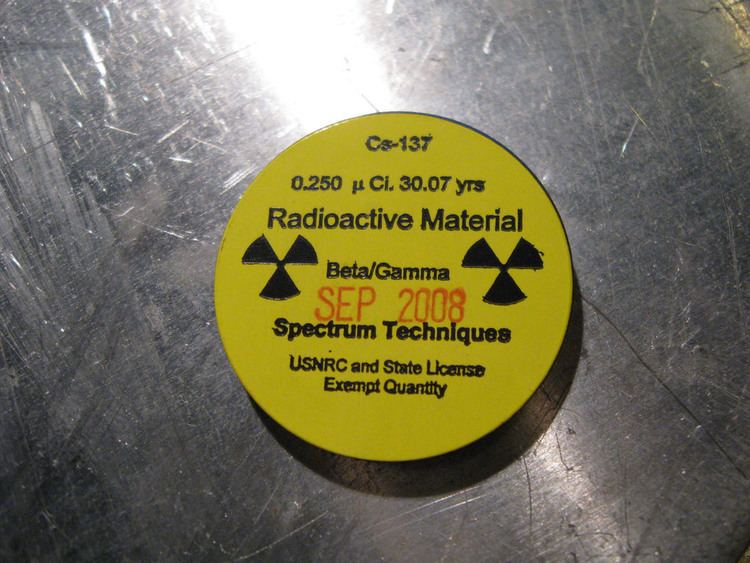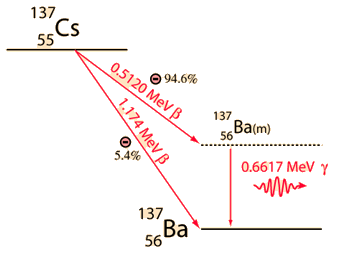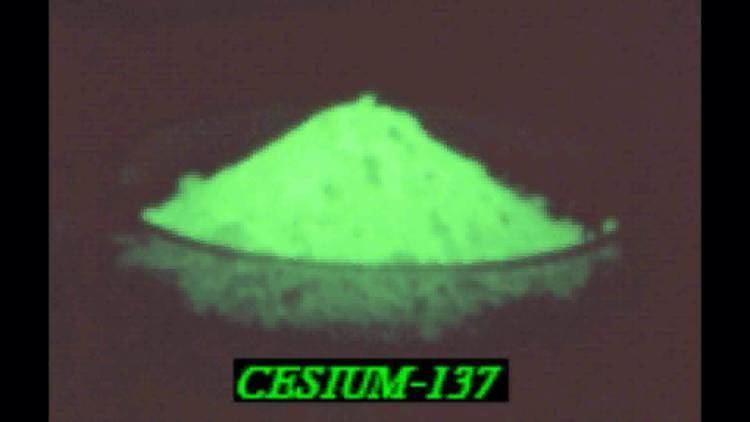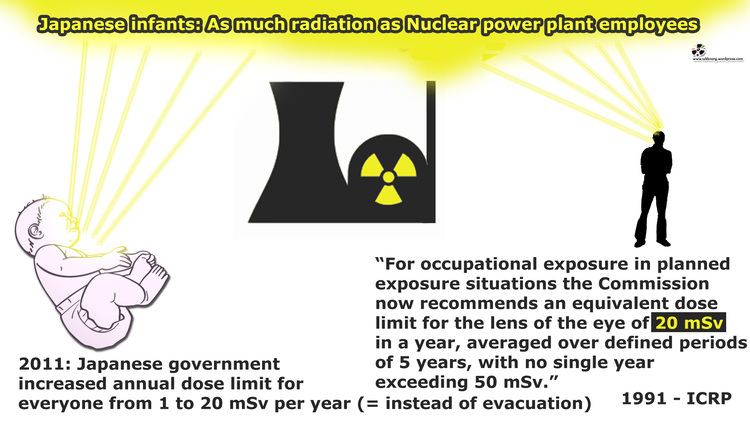Protons 55 | Neutrons 82 | |
 | ||
Caesium 137
Caesium-137 (137
55Cs
, Cs-137), cesium-137, or radiocaesium, is a radioactive isotope of caesium which is formed as one of the more common fission products by the nuclear fission of uranium-235 and other fissionable isotopes in nuclear reactors and nuclear weapons. It is among the most problematic of the short-to-medium-lifetime fission products because it easily moves and spreads in nature due to the high water solubility of caesium's most common chemical compounds, which are salts.
Contents
- Caesium 137
- Decay
- Uses
- Health risk of radioactive caesium
- Radioactive caesium in the environment
- 1987 Goinia Gois Brazil
- 1989 Kramatorsk Donetsk Ukraine
- 1998 Los Barrios Cdiz Spain
- 2009 Tongchuan Shaanxi China
- March 2015 University of Troms Norway
- 3 March 2016 Helsinki Uusimaa Finland
- References

Decay

Caesium-137 has a half-life of about 30.17 years. About 95 percent decays by beta emission to a metastable nuclear isomer of barium: barium-137m (137mBa, Ba-137m). The remainder directly populates the ground state of barium-137, which is stable. Ba-137m has a half-life of about 153 seconds, and is responsible for all of the emissions of gamma rays in samples of caesium-137. One gram of caesium-137 has an activity of 3.215 terabecquerel (TBq).
The main photon peak of Ba-137m is 662 keV.
Uses

Caesium-137 has a number of practical uses. In small amounts, it is used to calibrate radiation-detection equipment. In medicine, it is used in radiation therapy. In industry, it is used in flow meters, thickness gauges, moisture-density gauges (for density readings, with americium-241/beryllium providing the moisture reading), and in gamma ray well logging devices.

Caesium-137 is not widely used for industrial radiography because it is quite chemically reactive, and hence difficult to handle. The salts of caesium are also soluble in water, and this complicates the safe handling of caesium. Cobalt-60, 60
27Co
, is preferred for radiography, since it is chemically a rather nonreactive metal and produces higher energy gamma-ray photons.

As a man-made isotope, caesium-137 has been used to date wine and detect counterfeits and as a relative-dating material for assessing the age of sedimentation occurring after 1954.
Health risk of radioactive caesium
Caesium-137 reacts with water, producing a water-soluble compound (caesium hydroxide). The biological behavior of caesium is similar to that of potassium and rubidium. After entering the body, caesium gets more or less uniformly distributed throughout the body, with the highest concentrations in soft tissue. The biological half-life of caesium is rather short, at about 70 days. A 1972 experiment showed that when dogs are subjected to a whole body burden of 3800 μCi/kg (140 MBq/kg, or approximately 44 μg/kg) of caesium-137 (and 950 to 1400 rads), they die within 33 days, while animals with half of that burden all survived for a year.
Accidental ingestion of caesium-137 can be treated with Prussian blue, which binds to it chemically and reduces the biological half-life to 30 days.
Radioactive caesium in the environment
Caesium-134 and caesium-137 were released into the environment during nearly all nuclear weapon tests and some nuclear accidents, most notably the Chernobyl disaster and the Fukushima Daiichi disaster.
As of 2005 and for the next few hundred years, caesium-137 is the principal source of radiation in the zone of alienation around the Chernobyl nuclear power plant. Together with caesium-134, iodine-131, and strontium-90, caesium-137 was among the isotopes distributed by the reactor explosion that constitute the greatest risk to health. The mean contamination of caesium-137 in Germany following the Chernobyl disaster was 2000 to 4000 Bq/m2. This corresponds to a contamination of 1 mg/km2 of caesium-137, totaling about 500 grams deposited over all of Germany. In Scandinavia, some reindeer and sheep exceeded the Norwegian legal limit (3000 Bq/kg) 26 years after Chernobyl. As of 2016 the Chernobyl caesium-137 has decayed by half, but can have been locally concentrated by much larger factors.
In April 2011, elevated levels of caesium-137 were also being found in the environment after the Fukushima Daiichi nuclear disasters in Japan. In July 2011, meat from 11 cows shipped to Tokyo from Fukushima Prefecture was found to have 1,530 to 3,200 becquerels per kilogram of Cs-137, considerably exceeding the Japanese legal limit of 500 becquerels per kilogram at that time. In March 2013, the Japanese utility that owns the tsunami-damaged nuclear power plant said that it had detected a record 740,000 becquerels per kilogram of radioactive caesium in a fish caught close to the plant. That is 7,400 times the government limit for safe human consumption.
Caesium-137 is reported to be the major health concern in Fukushima. The government is under pressure to clean up radioactivity from Fukushima from as much land as possible so that some of the 110,000 people can return. A number of techniques are being considered that will be able to strip out 80% to 95% of the caesium from contaminated soil and other materials efficiently and without destroying the organic material in the soil. These include hydrothermal blasting. The caesium precipitated with ferric ferricyanide (Prussian blue) would be the only waste requiring special burial sites. The aim is to get annual exposure from the contaminated environment down to 1 millisievert (mSv) above background. The most contaminated area where radiation doses are greater than 50 mSv/year must remain off limits, but some areas that are currently less than 5 mSv/year may be decontaminated, allowing 22,000 residents to return.
Caesium-137 in the environment is substantially anthropogenic (human-made). Unlike most other radioisotopes, caesium-137 is not produced from the same element's nonradioactive isotopes but as a byproduct of the nuclear fission of much heavier elements; until the building of the first artificial nuclear reactor, the Chicago Pile-1, in late 1942, caesium-137 had not occurred on Earth in significant amounts for about 1.7 billion years. By observing the characteristic gamma rays emitted by this isotope, one can determine whether the contents of a given sealed container were made before or after the first atomic bomb explosion (Trinity test, 16 July 1945), which spread some of it into the atmosphere, quickly distributing trace amounts of it around the globe. This procedure has been used by researchers to check the authenticity of certain rare wines, most notably the purported "Jefferson bottles". The short life of Cs137 across the Earth's entire surface also means one can date soils and sediments.
1987 Goiânia, Goiás, Brazil
Caesium-137 gamma sources have been involved in several radiological accidents and incidents. Perhaps the best-known case is the Goiânia accident of 1987, in which an improperly disposed of radiation therapy system from an abandoned clinic in the city of Goiânia, Brazil, was scavenged from a junkyard, and the glowing caesium salt sold to curious, uneducated buyers. This led to four deaths and several serious injuries from radiation exposure. Caesium gamma-ray sources that have been encased in metallic housings can be mixed in with scrap metal on its way to smelters, resulting in production of steel contaminated with radioactivity.
1989 Kramatorsk, Donetsk, Ukraine
The Kramatorsk radiological accident happened in 1989 when a small capsule containing highly radioactive caesium-137 was found inside the concrete wall of an apartment building in Kramatorsk, Ukrainian SSR. It is believed that the capsule, originally a part of a measurement device, was lost in the late 1970s and ended up mixed with gravel used to construct the building in 1980. Over 9 years, two families lived in the apartment. By the time the capsule was discovered, 6 residents of the building had died from leukemia and 17 more had received varying doses of radiation.
1998, Los Barrios, Cádiz, Spain
In the Acerinox accident of 1998, the Spanish recycling company Acerinox accidentally melted down a mass of radioactive caesium-137 that came from a gamma-ray generator.
2009 Tongchuan, Shaanxi, China
In 2009, a Chinese cement company (in Tongchuan, Shaanxi Province) was demolishing an old, unused cement plant and did not follow standards for handling radioactive materials. This caused some caesium-137 from a measuring instrument to be included with eight truckloads of scrap metal on its way to a steel mill, where the radioactive caesium was melted down into the steel.
March 2015, University of Tromsø, Norway
In March 2015, the Norwegian University of Tromsø lost 8 radioactive samples including samples of caesium-137, Am-241 and strontium-90. The samples were moved out of a secure location to be used for education. When the samples were supposed to be returned the university was unable to find them. As of 4 November 2015 the samples are still missing.
3 March 2016 Helsinki, Uusimaa, Finland
On 3 and 4 March 2016, unusually high levels of caesium-137 were detected in the air in Helsinki, Finland. According to STUK, the country's nuclear regulator, measurements showed 4,000 μBq/m³ — about 1,000 times the usual level. An investigation by the agency traced the source to a building from which STUK and a radioactive waste treatment company operate.
